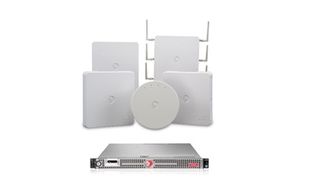Enterasys launches first ultra dense WiFi technology device
Why 802.11ac isn't worth buying until version two

We've all been there, you're at a conference and there's little or no mobile signal, but luckily the conference organisers have free WiFi. But due to the sheer number of users logging on, and the bandwidth hogging man in the back-row in the unwashed Star Wars t-shirt downloading 200Gb of video, all you get is a trickle of data.
While the example above doesn't happen every day, Mark Pearce, Strategic Alliance Director EMEA from Enterasys thinks the problem isn't just going to be a problem confined to conferences, large stadiums and high-bandwidth applications. It's something that will affect many businesses who will need to support bring your own devices (BYOD) initiatives.
"The impact of these millions of BYOD devices coming on to corporate networks over the next few years is going to be felt via the wireless LAN infrastructure. Historically WiFi implementations in businesses haven't really been designed or implemented as a mission critical infrastructure, but as a solution to provide just a small amount of connectivity and maybe some guest access. You can start to see this impact happening on networks in Universities where students have three or four devices connecting sometimes consecutively and the impact on the wireless network is massive."
To fix the problem Enterasys has launched its new identiFi solution, and it's aimed initially at issues associated with large numbers of users and for applications where a reliable data transfer speed are crucial, such as stadiums, venues and workplaces where multiple time-critical high-bandwidth applications such as VOIP and video conferencing are in use.
The new Enterasys IdentiFi system – it's a mix of access points, controllers and previously announced OneFabric control Center software - claim to be able to double normal high definition video performance and support 2,000 Access Points (APs) with up to 32,000 users per controller.
Standard features of the IdentiFi access points include;
- Up to 200 video sessions per access point
- Gigabit Ethernet ports – No bottlenecks to the network
- Multiple antennas – The three antenna 3765i/e allows one antenna to be ring-fenced for security
- 802.11ac ready – The device will support the as yet to be ratified new WiFi standard
- Low-power consumption
Additionally a new feature of the device is RS Fingerprinting, which gives the access point the ability to do dynamic channel hopping. Pearce, explains, "One of the antennas is dedicated to scanning across the channels while the other two provide client activity, if it detects noise or interference from Bluetooth or microwave, it will automatically direct you to another interference- free channel."
Are you a pro? Subscribe to our newsletter
Sign up to the TechRadar Pro newsletter to get all the top news, opinion, features and guidance your business needs to succeed!
Be wary of the 802.11ac standards
Above the access points are the new IdentiFi Controllers that manage the network connections to the access points which will also be 802.11ac compatible. As Pearce explains the new standard may not provide any faster devices in it's first versions. "The new 11ac standard is coming closer and our products will support it as and when it's ratified. We are recommending to end users to be wary of the new 802.11ac. standards. The benefits of 802.11ac won't be available to them in the first iteration of the standard, and our advice is to design for the new 5GHz channel but there should be no mad rush to buy an 802.11ac compliant tool today. The new 802.11ac points will be expensive and you're unlikely to see a real benefit from it, in fact our performance figures today will be faster than when the first versions of 802.11ac come to market."
Additionally there's a web-based management tool OneFabric Control Center that gives IT managers a real-time dashboard that allows them to see the amount of data being used on the WiFi network, the number of connections, types of devices and the operating systems of the devices using the system. The tool also allows the system to do some sophisticated things like blocking certain handsets from the network, or restricting usage to certain parts of the network.
